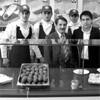From street vendor to Turkey’s first factory
by Müge Akgün - Referans

refid:10894643 ilişkili resim dosyası
Those who die for steak tartar or meat carpaccio start talking about the dangers of raw meat when the matter is southeast Anatolia’s famous çiğköfte, a Turkish meatball prepared from raw meat and wheat.
It is very natural for those who don’t like raw meat or hot pepper not to eat çiğköfte. If meat is eaten raw, it should be mixed with peppers, wheat and some vegetables. And of course it should be prepared in a clean environment.
Ahmet Arslan, who was a lathe operator in the eastern Anatolian city of Elazığ, moved to Istanbul in 1997 because he was very tired of working only in summers and doing nothing in winters. He worked as a taxi driver and a carpet seller for a few months, but after a while realized that food was a very good source of income in the city and that there were not many places selling çiğköfte, which he knew how to prepare well.
His relatives criticized him saying, "You had a lathe factory job in your own town and now will you sell çiğköfte on the streets?" But he didn’t listen to them and brought his family to Istanbul. He bought a mobile food stand and started selling çiğköfte in Avcılar Yanyol. After the Marmara earthquake in 1999, he rented a store and enlarged his business.
Sometime later, he opened his first branch opposite the famous Set Kebab House in the Etiler district. His son Murat started working with his father after finishing high school and he opened new branches. As demand increased, he decided to establish a factory.
In 2003, he bought a 1,500-square-meter building for $500,000 where the factory is operating now. He turned the building into a modern production facility with cold storage, offices and kitchens. Thanks to his knowledge of the lathe business, Arslan designed a huge çiğköfte-molding machine.
Certified çiğköfteHe also successfully applied to the Ministry of Agriculture for çiğköfte production certificate and capacity report. Today, his factory produces one ton of çiğköfte each day and has an annual turnover of 1 million Turkish Liras. Elazığlı Çiğköfteci Ahmet Usta has 18 branches all over Istanbul from Bostancı to Bakırköy, and from Ataköy to Fındıkzade, in Çorlu and İzmit.
His son Murat, the director of the factory, did not have a chance to attend university but his two daughters did. Nilay Arslan now heads the advertisement and promotion department, and İlknur Arslan heads the financial department. Their father is responsible for production as usual.
Varieties like çiğköfte, çiğköfte burger and çiğköfte with cheese for veggies are produced in the factory. Their most recently developed product is organic çiğköfte, which is produced naturally and without additives or chemicals. They have received the European Union’s certification of Environmental Standard, or CERES. All products in the factory are inspected every two months.
The factory attaches great importance to hygiene. It is forbidden to enter the kitchens and cold storage without wearing a galosh, an apron and headgear. Only Ahmet Usta and his two assistants can enter the room where çiğköfte is molded. The recipe is a secret. The only thing they will say is that their çiğköfte contains nearly 20 percent fat meat and dark wheat.
Price for a package that includes 12 çiğköftes, salad, lemon, a special sauce and lavaş (thin dough) is 9.5 Turkish Liras. A package with three çiğköftes is 6.5 liras. Nilay Arslan said çiğköfte was very suitable food for a diet because each serving has just 60 calories. She said it was offered during the International Medicine Congress that was held last year in Istanbul, and highly demanded for special invitations in recent years.
Elazığlı Çiğköfteci Ahmet Usta factory:
0212 428 5110
